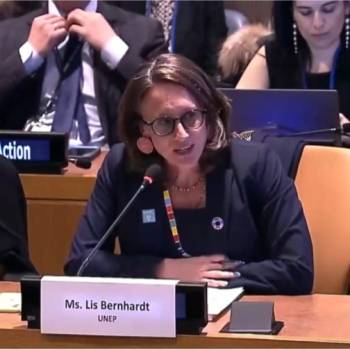
Earlier this week, the United Nations Environment Programme (UNEP) released a report that examines the status of research along with the potential risks and impacts of solar radiation modification (SRM), a group of technologies that aim to cool the planet.
We recently discussed the findings of the report One Atmosphere: An independent expert review on SRM research and deployment with UNEP’s Chief Scientist Andrea Hinwood.
Why is UNEP publishing a report on SRM?
Andrea Hinwood (AH): UNEP’s role is to keep the environment under review and that includes examining new technologies that impact the planet. There has been increasing demand for information about SRM, including calls for more inclusive and responsive modelling and scenario-building and requests to explore the potential governance of these controversial climate intervention technologies.
In close consultation with other UN entities, an Independent Expert Panel undertook a review of the existing state of knowledge on SRM to help inform the global community about the potential environmental and social impacts. It has been clear for some time that a growing number of Member States and both proponents and critics of SRM are calling for an international assessment of the latest knowledge to inform both national decisions, environmental policy and global governance in this space.
By convening a multidisciplinary Expert Panel, this rapid review has helped UNEP gain an understanding of the latest research and what we do and don’t know about SRM. Based on this work and the findings of the Expert Panel, UNEP is deeply concerned about the lack of empirical knowledge on the potential risk, impacts and unintended consequences. We need to know more, and we support the call for a comprehensive scientific review process that is inclusive and globally representative.
What is SRM and why is UNEP concerned about the technologies?
AH: SRM includes technologies to cool the planet, the most mature of which is stratospheric aerosol injection. This involves injecting aerosols into the stratosphere, so a small amount of sunlight is deliberately reflected into space to cool the planet. This process is similar to what happens when volcanoes erupt and aerosols are pushed into the stratosphere, with measurable cooling following.
While there is a growing body of literature and advanced modelling on the topic, which has been developing for many years, there is very little evidence or research on the risks and impacts of SRM. The report outlines these limitations in the evidence base. UNEP is concerned that while the scientific literature shows that SRM, and stratospheric aerosol injection specifically, can cool the globe, there is a dearth of data on the risks and impacts. For technologies that can alter the chemistry of the stratosphere, the world needs much more information to support decision-making.
Why is SRM so controversial?
AH: A range of concerns about SRM were raised in the report and included the scenario that if SRM were to be unilaterally deployed by a rogue state or non-state actor, like a private company, it could introduce a series of new complex geo-political or security threats. Questions are being raised regarding whether the knowledge and techniques generated through conceptual modelling and applied research might facilitate or exacerbate tensions and security risks.
While some of these security concerns are likely overstated, there is a notion that promoting or even considering SRM research options could increase geo-political tensions.
What risks does the report consider?
AH: The report outlines several risks, including the response of Earth’s climate and environmental systems to SRM. It looks at how these uncertain changes could affect human health and natural ecosystems, noting the lack of research on these aspects. It considers whether decisions would be made in an inclusive, equitable and transparent manner. It also highlights that SRM discussions might shift financial, political and intellectual resources from mitigation and adaptation efforts, known as the “moral hazard.” And the report covers how SRM deployment could lead to societal risks, including international conflicts, and how the technology could raise ethical, moral, legal and justice questions.
The report highlights that an inclusive process would involve discussion on a broad range of issues with all stakeholders as most, especially from the Global South, are not currently engaged in the SRM discussion. It notes that the UN is well-positioned to promote a responsible global conversation on SRM that could help uphold the highest standards of balance, rigour and accuracy.
Does UNEP think we have lost the battle to reduce the greenhouse gas emissions that are driving the climate crisis?
AH: Not at all. First, the scientific assessment of potential hazards that can stem from new technologies is critical to avoid potentially catastrophic consequences. Second, it is important people understand that SRM technologies, should they be considered at some point in the future, do not solve the climate crisis because they do not reduce greenhouse gas emissions nor reverse the impacts of climate change. The world must be crystal clear on this point.
Issues such as ocean acidification, sea level rise, the increasing intensity and frequency of weather events, changes in species distribution and pollution will continue unless they are tackled directly. The evidence is irrefutable: the world can and must act swiftly, decisively, and immediately to reduce emissions to avoid the worst consequences of climate change. UNEP will therefore continue to strengthen its efforts to address the triple planetary crisis of climate change, nature and biodiversity loss, and pollution and waste.
The new report said solar radiation modification is unwise at the moment. Why?
AH: UNEP concurs with the panel that, at present, large-scale, or operational deployment of SRM technologies is not necessary, viable, prudent or sufficiently safe, given the limited scientific understanding and uncertainty about the potential impacts and unintended consequences. The review concludes that SRM cannot replace reducing greenhouse gas emissions. Even with deployment -- mitigation efforts will remain critical for decades to come.
Does UNEP think we should undertake a scientific review of SRM and if so, what would it recommend?
AH: UNEP is cognizant that although SRM technologies remain largely speculative, and deployment is not predicted within the next few years, research is taking place and continues. Outdoor experiments are being proposed as these technologies are gaining traction as a possible last resort.
The only way to adequately address the uncertainties and risks of SRM is through review, research, debate and discussion – objectively establishing evidence through testing and experimentation. Therefore, UNEP supports the scientific review of SRM technologies so that the risks and uncertainties can be appropriately assessed to support sound decision-making on an issue that affects everyone.
SRM deployment in one country could have impacts regionally and globally, and those impacts are unclear at this point. As illustrated in the title of the report: we have “one atmosphere.” Everyone is a stakeholder.
This is also why UNEP advocates for a scientific review process that includes those currently engaged in research, those without access to the science, and communities who lack the ability to influence and contribute fairly to the advancement of research. In particular, indigenous and community groups need to be engaged, but particularly those in the Global South where the vulnerabilities to climate change are greater, access to scientific information is limited and, more broadly, the fact that local knowledge is not given prominence.
Could this technology distract from the effort to cut emissions?
AH: There is concern that SRM research could reduce incentives to mitigate greenhouse gas emissions. It could do this either by creating expectations that an SRM deployment could reduce adverse consequences of high greenhouse gas concentrations or by drawing financial, political or intellectual resources away from mitigation and adaptation efforts.
By supporting the call for scientific review, is UNEP effectively arguing against a ban on large-scale operational deployment of SRM?
AH: At UNEP, our role is to be pro-active and respond to calls to fill knowledge gaps in our understanding of the environment. Research has been underway for decades to establish whether these technologies can be used to cool the planet. So, while UNEP is concerned, it is naive to think research will cease and the issues will disappear. We cannot afford to bury our heads in the sand.
What we need is the best evidence base we can have to make informed decisions. An important question is how to balance general principles of freedom of scientific inquiry with the need to manage risks related to scientific and technical experimentation. This is particularly relevant in environments such as the stratosphere, where little exists in the way of regulatory or governance structures. Furthermore, we must encourage scientific openness and transparency, and where necessary, together with the international scientific research community, provide appropriate safeguards and oversight on the local, national and international outcomes of such research.
What are the next steps?
AH: UNEP and other UN agencies are laying the groundwork for a full-scale global review of SRM, including preparing an assessment framework.
In January 2023, the Montreal Protocol Scientific Assessment Panel released a report on the potential impacts of SRM deployment on the ozone layer. Its findings are consistent with those from the expert panel report. The expert panel report contains further information about additional impacts and risks and covers a wider view of the issues associated with SRM research and deployment.
Source : United Nations Environment Programme - UNEP
Posted on 2023-03-02 15:06








Comments